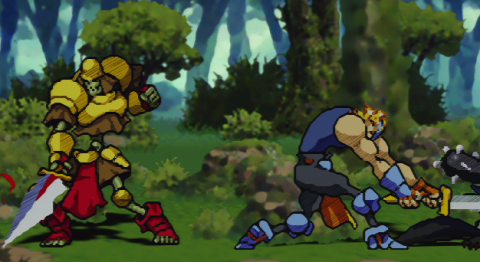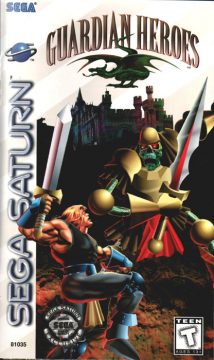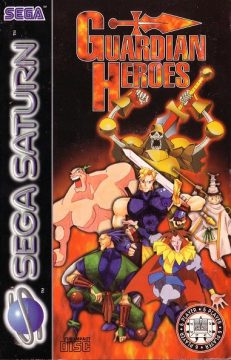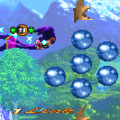- Guardian Heroes
- Advance Guardian Heroes
Traditionally, beat-em-ups have all been about strutting forward, punching some dudes, and then walking forward some more. Their depth usually lies in the playable characters, variety of moves, and types of enemies, but there are a mere few games that deviate from this. Some of the most well noted include River City Ransom and Capcom’s Dungeons & Dragons arcade titles, both which introduce RPG elements to liven things up a bit.
Famously rad developer Treasure – they of the magnificent Gunstar Heroes, still one of the best side scrolling shooters ever – looked at the landscape of beat-em-ups, and decided that they could do better. Their game, dubbed Guardian Heroes, includes experience building elements with a variety of statistics that can be upgraded, a relatively large story with a number of NPCs and plenty of dialogue, a number of branching paths that lead to multiple different endings, five playable characters with their own distinct movesets, a number of magic spells, an AI controlled monster that you can command, and game mechanics that borrow closely from 2D fighters like Street Fighter II. And all of this comes together using the impressive sprite handling capabilities of the Saturn, allowing for nearly a dozen characters on screen at once, along with screen scaling effects. Yeah, that’s pretty awesome.
The character designs were done by HAN, Treasure’s resident artist, so some of the characters look a bit like the cast of Gunstar Heroes. Instead of that game’s futuristic landscapes, Guardian Heroes takes place in a medieval fantasy universe, filled with swords, sorcery, and the occasional laser-spewing robot to mix things up a bit. The story begins when a gang of adventurers discover an ancient sword. Little do they know that the Kanon, the scheming adviser to the king – is hunting for this very same artifact, and is using the Royal army to do his bidding. After being chased out of town, they discover that the sword can summon a fearsome undead creature called the Golden Warrior, who takes up arms to fight alongside you in the conflict.
Characters
Samuel Han
Guardian Heroes‘ resident tank, Han carries a damn huge sword. The fact that he shares a name with the character designer is probably not a coincidence.
Randy M. Green
Randy is the resident mage – physically weak, but with the best magical spells. He also has a little rodent for a pet, which shadows his every movement.
Ginjirou Ibushi
The martial arts expert who moves and attacks like a ninja. He can create hugely long combos and even has some decent magic spells.
Nicole Neale
Nicole is primarily focused on defensive magic, but she’s a good all around character too.
Serena Corsaire
This badass knight warns the Guardian Heroes of the power of the sword, and fights alongside them in a few levels. She’s only playable after beating the game.
Kanon’s idiotic right hand man, Zur is a clownish jester who nonetheless continually torments our heroes.
The fighting in Guardian Heroes is heavily based on the Yu Yu Hakusho fighting game that Treasure developed for the Mega Drive. While that capped the experience as a match-based four-player rumble, Guardian Heroes transforms it into a sidescrolling brawler. The B and C buttons execute weak and strong attacks respectively, while the A button is used for blocking. It’s a very fast and friendly system, and it’s very easy to execute combos, knock enemies skyward and juggle them in mid-air.
The playing field is divided into three planes – the foreground, middle ground, and background, similar to SNK’s Fatal Fury. By pressing the trigger buttons, you can leap between the planes. In your typical beat-em-ups, you’d normally just push up or down to move around the scenery, but this frees up the controls so it can play more like 2D fighting games. Pressing Up will jump, and most characters have the ability to double jump as well. Each character also has a number of special movies that are executed with command motions, allowing for a larger moveset than your typical Final Fight clone. Altogether, the whole experience feels like a predecessor to Arc System’s Guilty Gear series, which actually implemented similar mechanics (with less than stellar success) in a spinoff title, Guilty Gear Isuka.
In fact, the Guardian Heroes actually has its roots in a mecha-themed beat-em-up called Mad Stalker: Full Metal Force, developed for the X68000 by Fill-in Cafe (and also ported to the PC Engine and PlayStation). Designed by Masatoshi Imaizumi and Masaki Ukyo, the duo (both individually and jointly), created several other similar games over the years, including Guardian Heroes, as well as Panzer Bandit, Code of Princess, and Phantom Breaker: Battle Grounds. The same basic fighting system was used in the fighting game Asuka 120% Burning Fest, a one-on-one fighter featuring an (almost) entirely female cast.
The X button is the Magic button – you can bring up a menu to select a spell, but it’s generally much easier to memorize a command motion and cast them that way. The Z button commands the Golden Warrior, giving him vague orders to defend your character or attack all out. You can also order him to go out all berserk, triggering a minor nuclear explosion to beautifully wipe the screen clear of dies. Trying to tell your undead pal what to do can get a bit hectic though – you need to run off to an empty corner of the screen before you can even hope to issue a command without getting knocked to the ground first.
Lots of people like to classify beat-em-ups as mindless button mashers designed to milk quarters from gullible arcade goers. It’s true that a number of poorly designed games fall into this category, but in order to succeed in the better beat-em-ups, you need to learn the concept of crowd control – this is, being able to position enemies so you don’t get attacked from all angles. Most beat-em-ups only allow you to attack one or two enemies at the same time (not counting super moves to wipe out numerous enemies.) However, due to the multi-plane system and powerful attacks, Guardian Heroes lets you take out a number of foes – potentially half a dozen or more – with a single, well timed strike, and that immense power is largely what makes the pummeling so satisfying. The thing is, within Guardian Heroes‘ greatest strength also lies its greatest weakness – with its constant state of madcap havoc, there are only a few sparse moments where the screen isn’t flooded with enemies. As such, it’s tough to see exactly what’s going on, especially if you’re on the background plane.
The fighting engine is more than solid, but Guardian Heroes adds a number of RPGs elements that greatly expands its depth. As you wail on enemies, you’ll gain experience points, and eventually level up. At the end of each stage, you’re allowed to increase one statistic per each level gained. These include the usual strength, defense, magic, luck and agility statistics, and allow you to customize warriors to better suit your tastes. Han, for example, has low MP at the beginning of the game, but you can fix that, if you want. Given that there’s a limited amount of enemies in the game, technically the amount of experience you can gain is fixed. However, if you continue to juggle dead foes before they hit the ground, you’ll continue to rack up experience. To counterbalance this, there’s a karma system, which will drop whenever you juggle bad guys or destroy civilians, or increase whenever you let an enemy retreat. Although there are seven basic endings, your karma will alter a portion of the dialogue at the end.
There’s also a pretty sizable storyline, with a number of recurring villains. It’s all pretty much standard fantasy stuff, and the dry English writing doesn’t help make things any more interesting. However, the most interesting feature is the branching paths. After certain levels, you’re given a variety of choices that affect the route through the game. There are a total of thirty stages, complete with seven endings and five different final bosses. Unfortunately, there’s no way to skip the cutscenes, which grows bothersome. All of the paths intersect at one point before diverging again, and with each playthrough, you’ll have to sit through the same, long winded speech about the history of the game universe.
If the expansive story mode weren’t enough, Guardian Heroes offers up an awesome multiplayer mode. Although there are only five playable characters available in the regular story mode, Guardian Heroes goes all out with its battle royale feature, where you can play as ANY character once you’ve unlocked them in the regular mode. This includes a total roster of over forty characters. Naturally, it’s incredibly unbalanced when you’re playing as Natto, Randy’s tiny rodent with next-to-zero HP, and your opponent’s playing as a giant planet boss character that takes up half the size of the screen. But if you’ve got a Saturn multiplayer adapter – and enough controllers – up to six people to can join in to pummel each other ruthlessly. It’s a fantastic party game that foreshadowed the popularity of Super Smash Bros. and other similarly themed games.
It’s interesting to see how Guardian Heroes evolved out of Gunstar Heroes. Most of Gunstar Heroes‘ stages were punctuated by huge boss fights and fast paced setpieces, with the exception of a single stage. This stage, the fifth level, simply commands you to “DESTROY THEM ALL!”, and is a fairly long playing field consisting of nothing but bad guys pouring out from every corner of the screen. Guardian Heroes borrows its philosophy from this stage, as the levels are little more than brief, flat playing fields. The game simply pumps out more and more enemy soldiers until its satisfied itself, and then you move on. There are boss battles to fight, but they’re hardly the calculated showdowns that Treasure is known for – they’re usually just like regular foes, except larger, with fancier attacks and more hit points. In fact, there’s really no single moment that sticks out as being particularly memorable. But, in the end, that may not necessarily be a bad thing – Guardian Heroes is about emerging battle techniques amidst chaos, and a rigid structure wouldn’t serve the game well at all. Anyway, even if the game does grow a bit repetitive, the game saves after each level. If you get tired, you can always take a break and come back later, since it saves your progress after each level.
The levels consist of the usual fantasy fare – towns, graveyards, castles and caves – and generally lacks the imaginative flair that come to punctuate most Treasure titles. At least the character sprites are decent. They’re drawn with bright colors outlined in black, which adds a nice animation-quality look to the visuals. However, with all of the sprites scaling going on – either when you leap between planes or when the screen zooms out – the characters get pretty pixellated and jaggy, but that’s to be expected. The number of sprites on the screen will occasionally slow down the action and completely bring the Saturn to its knees, but it’s not consistent enough to ruin the action, and something like this would’ve undoubtedly choked on the PlayStation.
Since Guardian Heroes is Treasure’s first CD-ROM game, it gave the Nazo2, the composer, the chance to graduate from the staticy Genesis sound chip. The music is the type of synth rock you’d find on early 90s PC Engine games. Some tracks break out a guitar to lend them a heavier edge, and a few even utilize a saxophone, bringing a bit of unique jazz flavor to the beat-em-up action. None of the lines are voiced, outside of some exclamations made by certain enemies.
The American and European Saturn versions of Guardian Heroes command sizable prices on the secondary market, but the Japanese version is a bit cheaper and easier to find. Although you may need a FAQ to read the stats at the level up screen or need the script to understand which branch you’re taking, it’s still perfectly playable in Japanese. The only other real difference is that the voices and sound effects in the intro movie were removed for the English version, leaving only music.
In 2011, Treasure ported Guardian Heroes to the Xbox 360, sold exclusively on the Xbox Live Arcade. It’s no quick and dirty emulation, though, as it features a number of enhancements. The playing field has been extended to fit the full 16:9 widescreen ratio, with an option to use the original low-res graphics, or updated high def visuals. Though most upscaling filters look quite ugly, the one in Guardian Heroes is actually pretty decent, as it gives the sprites a pencil shade look, and some of the larger monsters have been redrawn. The backgrounds, however, are still blurry. The character portraits have been redrawn, and there’s a brand new GUI with new artwork as well. The Saturn intro is hidden away in a menu, though it runs at its original resolution and suffers from blocky compression, though the sound effects and voices have been restored. The script has been retranslated and is generally much better than the original. The dialogue is much livelier, with everyone having goofier character quirks, like Genjiro’s vaguely silly metaphors.The Earth Spirits are now known as Earthblood, and the Sky Spirits are now Skyborn, taking less literal but better sounding monikers. A comparison example of the introduction is below:
Saturn:
Han: Heh, heh! This is great! I never thought we’d find such a great sword by ourselves! I wonder if anyone else is looking for it.
Randy: Hey! Be careful! It is an old sword! What will you do if it breaks?!
Genjiro: Don’t worry! A great sword doesn’t break easily.
Randy: Is this really the sword we’ve been looking for? Let me see it!
Nicole: I don’t care about that sword! I’m tired! Let’s eat now.
Serena: The royal knights are coming!
Randy: The royal knights have arrived. There’s no way we can get away from them!
Genjrio: Everybody split up! We’ll be able to lose them.
Serena: They are after the sword.
Nicole: But where do we go from here?
Han: There is no time to talk! Let us meet at the graveyard ahead.
Xbox 360:
Han: You were right, Randy! The Sword of Legend WASN’T just a fairy tale! Doesn’t seem all that — HYAH! — special, though.
Randy: Wh-Whoa! Han, be careful! That’s centuries old! What if it’s fragile?
Genjiro: Bah! A sword that breaks is like a dog that meows.
Randy: Um, what? A-Anwyay, there’s no proof we’ve even got the right sword yet.
Nicole: You know how to find out: Go stab us some DINNER. I’ve got legendary hunger.
Serena: The royal knights are coming!
Randy: Um, how are we supposed to outrun an army?
Genjiro: Split up. A hundred kittens bite harder than one lion!
Serena: It’s the sword they want.
Nicole: But we WORKED for that sword.
Han: We can discuss it later. Just run! Meet you at the cemetery outside of town.
The “Original” mode uses the same controls and mechanics as the Saturn version, but the “Remix” mode makes several tweaks to the action. Among the many additions: three attack buttons for light, medium and heavy attacks, rather than just two; a whole button is now devoted to back dashing, which has a larger invulnerability window than before and can pass through characters, though it can now drain magic; all characters can now air-dash; you can now actually run as long as you want instead of just sprinting short distances; and a number of other tweaks. As you replay the game, it also keeps track of the plot branches, so you can easily tell which routes and levels you have yet to visit, plus you can fast forwarded through cutscenes. The status screen even keeps track of your karma now. The multiplayer mode features online play and expands the number of simultaneous players from six to twelve. There’s also a new Arcade mode, which challenges you to see how long you can last against a gamut of enemies, along with the ability to post your score to the leaderboards. Overall, it’s a brilliant conversion, paying respect to such a classic game while actually improving it as well.
Guardian Heroes is not technically related to Gunstar Heroes – it does, however, share the same spirit, where “spirit” is defined as “the incredible feeling one gets from causing extreme amounts of destruction with relative ease.” However, the final boss from Gunstar Heroes, Golden Silver, does make a cameo appearance in one of the penultimate conflicts. Additionally, the main bad guy from Gunstar Heroes is Emperor Gray, while the main foe of Guardian Heroes is Kanon G. Gray. Randy’s mentor is also named Brown, just like the assistant in Gunstar Heroes. However, they’re more for fan service than anything else.





